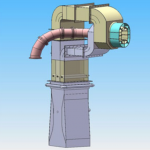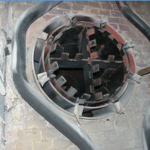The low-emission coal burners represent a new concept of coal powder combustion in applications suitable, in addition to new equipment, particularly for retrofitting boilers of the classical version.
The advantage of this type of burner is – in addition to the technical parameters – the possibility of economy-saving installation into the current boiler equipment without heavy modifications and interventions in the pressure parts.
From an operational point of view, the burners are mainly advantageous for combustion stability even at significant flexibility of changes in power output while observing the emission limits. More complete combustion is achieved by higher efficiency of the combustion process as well as boiler efficiency.
From the point of view of mechanical ruggedness, the burners are conceptually designed to prevent flame singeing of the exposed parts.
Description
New low-emission burners for coal powder combustion (see below shown illustration) consist of a circular burner powder duct providing the supply of the primary mixture containing coal powder to the centre burner mouth, and from the air part, which ensures combustion air distribution along the circumference of the burner mouth. The burner powder duct is equipped with a baffle cone and combustion intensifiers located mainly in the burner mouth.
The air part of the burner consists of two air distributing chambers and two concentric cylindrical annuluses supplying combustion air along the circumference of the burner mouth. The combustion air is thus divided into two parts, secondary (inner annulus) and tertiary (outer annulus). Both cylindrical annuluses are spread out by spacer ribs. Combustion intensifiers are also located at both cylindrical annuluses in the burner mouth.
The entire burner mouth in the length of approximately 300 mm and the combustion intensifiers are made of fire-resistant steel and the baffle cone is made of abrasion-resistant steel. Other parts of the burner are made of carbon steel, class 11.
Function
The baffle cone and the combustion intensifiers located in the burner powder duct ensure very good homogenization of the coal powder in the primary mixture under all operating conditions. The secondary air is supplied to the burner in such a quantity as to enable optimum mixing of the combustion air and the coal powder as well as stable combustion to a maximum output range. The quantity of the tertiary air is then controlled in such a way as to achieve optimum excess of combustion air on the burner, which achieves very low values of CO carbon monoxide and NOx nitrogen oxide emissions.
Regulace tepelného výkonu
New low-emission burners for coal powder combustion have unprecedented requirements for the combustion measuring and control system. To make use of the advantages of such burners to the full extent it is indispensable to measure and control separately both the total quantity of secondary and tertiary air flowing to the burners, and the quantity of fuel supplied to the individual operated mills. The quantity of secondary and tertiary air is not measured separately; the secondary and tertiary air is only redistributed to the burners by means of regulating flaps depending on the boiler output. The optimum heat output of one burner ranges from 10 to 30 MWt.
Advantages
- Stable combustion without high-grade fuel stabilization in a wide output range, whose lower limit starts at 35% of the boiler output
- Low emissions amounting to 120 mg/Nm3 for CO carbon monoxide and to 300 mg/Nm3 for NOx nitrogen oxides in a steady state of the boiler
- Low residual ash, which amounts to 2% for fly ash and to 10% for slag in a steady state of the lignite boiler
- Small erosion wear caused by solid particles
- No thermal wear
- Long time until necessary repair of the burners (minimum 4 years)
- Long service life of the burners (minimum 8 years)
Areas of application
The modular design of the burners as well as their variability enables various installations into boilers of different concepts.
- Lignite and coal boilers
- Possibility of installation both for powder coal boilers with low outputs (approximately 35 t/h), and for boilers with high outputs (approximately 650 t/h)
- Possibility of installation for powder coal boilers with direct as well as indirect coal powder blowing
Gallery
Want to know more? Contact us!




